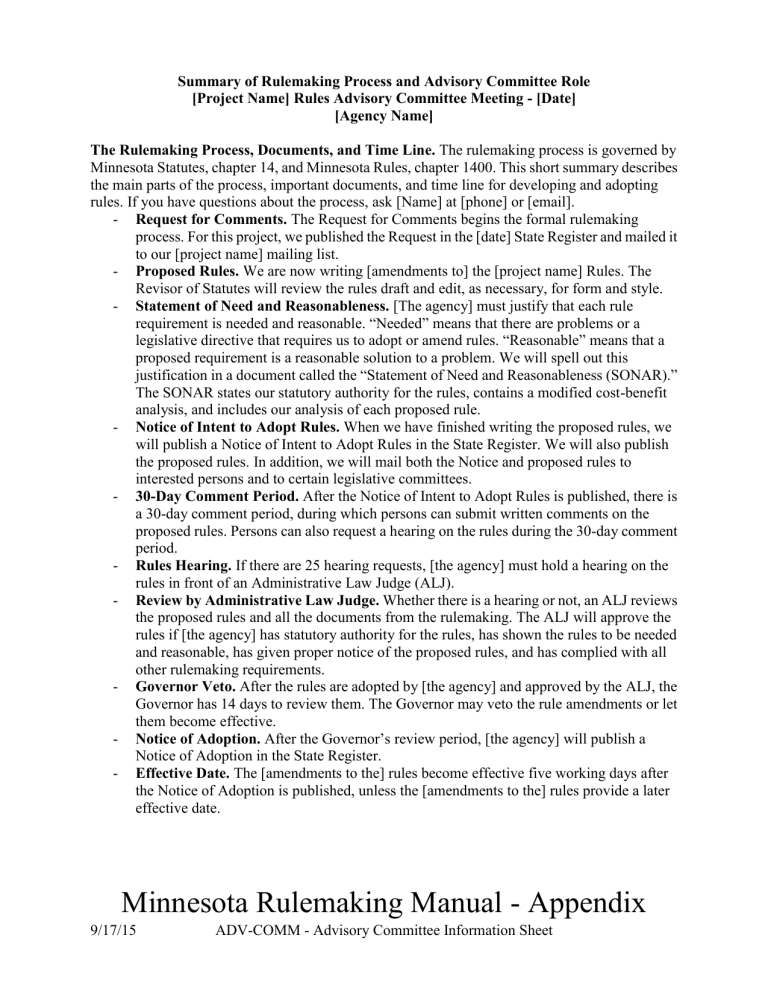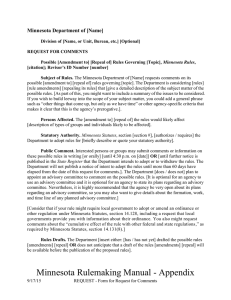Advisory Committee Information Sheet (Word file: 24KB/3 pages)

Summary of Rulemaking Process and Advisory Committee Role
[Project Name] Rules Advisory Committee Meeting - [Date]
[Agency Name]
The Rulemaking Process, Documents, and Time Line.
The rulemaking process is governed by
Minnesota Statutes, chapter 14, and Minnesota Rules, chapter 1400. This short summary describes the main parts of the process, important documents, and time line for developing and adopting rules. If you have questions about the process, ask [Name] at [phone] or [email].
Request for Comments.
The Request for Comments begins the formal rulemaking process. For this project, we published the Request in the [date] State Register and mailed it to our [project name] mailing list.
Proposed Rules.
We are now writing [amendments to] the [project name] Rules. The
Revisor of Statutes will review the rules draft and edit, as necessary, for form and style.
Statement of Need and Reasonableness.
[The agency] must justify that each rule requirement is needed and reasonable. “Needed” means that there are problems or a legislative directive that requires us to adopt or amend rules. “Reasonable” means that a proposed requirement is a reasonable solution to a problem. We will spell out this justification in a document called the “Statement of Need and Reasonableness (SONAR).”
The SONAR states our statutory authority for the rules, contains a modified cost-benefit analysis, and includes our analysis of each proposed rule.
Notice of Intent to Adopt Rules.
When we have finished writing the proposed rules, we will publish a Notice of Intent to Adopt Rules in the State Register. We will also publish the proposed rules. In addition, we will mail both the Notice and proposed rules to interested persons and to certain legislative committees.
30-Day Comment Period.
After the Notice of Intent to Adopt Rules is published, there is a 30-day comment period, during which persons can submit written comments on the proposed rules. Persons can also request a hearing on the rules during the 30-day comment period.
Rules Hearing.
If there are 25 hearing requests, [the agency] must hold a hearing on the rules in front of an Administrative Law Judge (ALJ).
Review by Administrative Law Judge.
Whether there is a hearing or not, an ALJ reviews the proposed rules and all the documents from the rulemaking. The ALJ will approve the rules if [the agency] has statutory authority for the rules, has shown the rules to be needed and reasonable, has given proper notice of the proposed rules, and has complied with all other rulemaking requirements.
Governor Veto.
After the rules are adopted by [the agency] and approved by the ALJ, the
Governor has 14 days to review them. The Governor may veto the rule amendments or let them become effective.
Notice of Adoption.
After the Governor’s review period, [the agency] will publish a
Notice of Adoption in the State Register.
Effective Date.
The [amendments to the] rules become effective five working days after the Notice of Adoption is published, unless the [amendments to the] rules provide a later effective date.
Minnesota Rulemaking Manual - Appendix
9/17/15 ADV-COMM - Advisory Committee Information Sheet
Time Line.
This process of drafting [amendments to] the rules can be open-ended, although we plan to complete the rules draft around [date]. The formal part of the rulemaking process, from publishing the Notice of Intent to Adopt Rules until the date the rules become effective, takes about three months if there is no hearing and about five months if there is a hearing.
The Role of the Advisory Committee.
Advice, not voting.
The role of the Advisory Committee is to advise [the agency] on the development of these rules. [The agency] looks to the Advisory Committee for its expertise in these regulations.] The Advisory Committee does not have voting authority on what will go in the rules; the [Commissioner] makes any final decisions. The Advisory Committee does, however, have the power of persuasion and the power that comes from having the information needed to make these rules workable.
Represent your interest group.
Each of you likely represents an interest group in one way or another, be it [for example: small hospitals or large hospitals, urban hospitals or rural hospitals, large health care organizations or small health care organizations, consumers, hospital administrators, hospital accounting departments, hospital professional organizations], and so on. We encourage you to maintain communication with others who share your interests.
Consensus.
Our goal is to achieve consensus on as many issues as possible. Even where there is disagreement on some issues, we hope to make the rules as workable as possible for those who have to comply with them.
Reasonable comments and suggestions.
We will carefully consider all comments and suggestions about the rules. You will have the most success persuading [the agency] with your comments and suggestions if you give reasons along the same lines as how [the agency] has to justify the need for and reasonableness of everything in the rules.
Regulatory Analysis.
Minnesota Statutes, section 14.131, lists eight factors that an agency must analyze when it adopts or amends rules. We will look to you for advice and information as we analyze these factors.
From Minnesota Statutes, section 14.131.
The SONAR “must include the following to the extent the agency, through reasonable effort, can ascertain this information:
(1) a description of the classes of persons who probably will be affected by the proposed rule, including classes that will bear the costs of the proposed rule and classes that will benefit from the proposed rule;
(2) the probable costs to the agency and to any other agency of the implementation and enforcement of the proposed rule and any anticipated effect on state revenues;
(3) a determination of whether there are less costly methods or less intrusive methods for achieving the purpose of the proposed rule;
(4) a description of any alternative methods for achieving the purpose of the proposed rule that were seriously considered by the agency and the reasons why they were rejected in favor of the proposed rule;
(5) the probable costs of complying with the proposed rule, including the portion of the total costs that will be borne by identifiable categories of affected parties, such as separate classes of governmental units, businesses, or individuals;
Minnesota Rulemaking Manual - Appendix
9/17/15 ADV-COMM - Advisory Committee Information Sheet
(6) the probable costs or consequences of not adopting the proposed rule, including those costs or consequences borne by identifiable categories of affected parties, such as separate classes of government units, businesses, or individuals;
(7) an assessment of any differences between the proposed rule and existing federal regulations and a specific analysis of the need for and reasonableness of each difference; and
(8) an assessment of the cumulative effect of the rule with other federal and state regulations related to the specific purpose of the rule.
Cost to Small Businesses and Small Cities . Minnesota Statutes, section 14.127, requires the agency to determine whether, in order to comply with proposed rules during the first year after they become effective, any small business or small city would have to spend over $25,000. A small business is defined as a business (either for profit or nonprofit) with less than 50 full-time employees. A small city is defined as a city with less than ten full-time employees. We will look to you for information about the cost of compliance for small businesses and cities.
Performance-Based Rules.
Minnesota Statutes, sections 14.002 and 14.131, require that the SONAR describe how the agency, in developing the rules, considered and implemented performance-based standards that emphasize superior achievement in meeting the agency’s regulatory objectives and maximum flexibility for the regulated party and the agency in meeting those goals.
[The agency] will look to you for advice and information on how we can make the rules work better for you, while still meeting our goals for these rules.
Are there any special situations that we should consider in developing the rules?
Are there any ways to reduce the burdens of the rules?
Do you have any other insights on how to improve the rules?
Additional Notice.
When [the agency] publishes the proposed rules and the Notice of Intent to Adopt Rules, we also have to “provide additional notification to persons or classes of persons who might be affected by the proposed rule or must explain why these efforts were not made.”
[The agency] will look to you to help us identify all interested persons and to come up with ways to let them know about the rules. This includes both likely supporters and opponents of the rules.
Local Government Impact
[The agency] has to evaluate the fiscal impact and benefits of proposed rules on local governments. As part of this, [the agency] has to consult with the Department of Minnesota
Management and Budget (MMB).
In addition to consulting with MMB, [the agency] will look to you to help us identify the fiscal impact and benefits of the proposed rules on local governments.]
Minnesota Rulemaking Manual - Appendix
9/17/15 ADV-COMM - Advisory Committee Information Sheet
![Minnesota Department of [Name] MEMORANDUM](http://s2.studylib.net/store/data/015049440_1-475d22d0ab7bd661c71329dec0ae8429-300x300.png)
